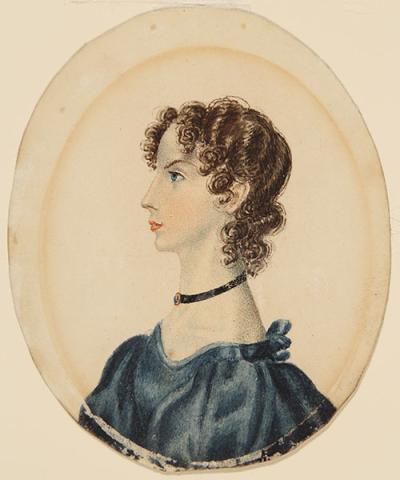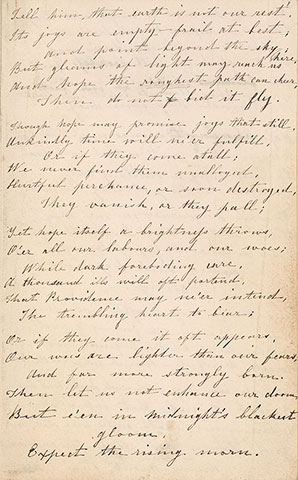
The Morgan Library & Museum holds the largest collection of literary manuscripts by Anne Brontë (1820–1849), all of which are presented here. Of the fifty-nine poems attributed to her, fifty-four survive in manuscript; of those, eighteen and a portion of a nineteenth are held at the Morgan. There are no surviving manuscripts of her two published novels, and no trace of what must have been a significant body of juvenile writings. Only a handful of her personal letters survive. The manuscripts reproduced here, therefore, comprise one of the richest material records of Brontë’s literary imagination.
Anne and her sisters Charlotte and Emily had been writing for years by the time they published a book of poetry at their own expense in 1846. Mindful that “authoresses are liable to be looked on with prejudice,” as Charlotte later put it, the three adopted ungendered pseudonyms—Acton, Currer, and Ellis Bell—masking their identities but retaining the initials of their real names. The book, entitled simply Poems, did not sell well, but its ambitious authors kept writing. Two years later, they were famous—and still pseudonymous. By 1848, Charlotte and Emily had each published a novel, Jane Eyre and Wuthering Heights, respectively; Anne had published two: Agnes Grey and The Tenant of Wildfell Hall. Anne died of tuberculosis the following year, in May 1849, at the age of twenty-nine.
The Morgan collection
In May 1900, the American financier and collector J. Pierpont Morgan received a letter from F. W. Wheeler of the London bookseller J. Pearson & Co., offering “a few manuscript volumes for your inspection.” Among the selections was a manuscript by Anne Brontë, which Wheeler claimed included “all her published poems and two that are unpublished.” Wheeler did not have the details quite right, but it was true that the manuscript (see MA 28) was a rarity. Morgan acquired it for £70. About a decade later, in 1911, he purchased Anne Brontë’s Bible and three family hymn books. One of Morgan’s last purchases before his death in 1913 was the manuscript of Charlotte Brontë’s first novel, The Professor.
At the same time, another American, Henry Houston Bonnell of Philadelphia, was building a still larger Brontë collection. Upon Bonnell’s death in 1926, the bulk of his collection went to the Brontë Society in England and became a cornerstone of the museum that opened in Haworth Parsonage two years later. Bonnell’s widow, Helen Safford Knowles Bonnell, retained some important manuscripts, letters, drawings, and books, and in 1963 placed them on deposit at the Morgan and began to donate them over the ensuing years. In April 1969, Mrs. Bonnell visited the Morgan to hear Howard Nixon’s lecture on Samuel Pepys and to see the display of one of the manuscripts she had given. She died the following day. Her bequest of the balance of the Henry H. Bonnell collection, when combined with J. Pierpont Morgan’s early purchases, made the Morgan one of the world’s most important repositories of Brontëana.
Introduction by Christine Nelson, Drue Heinz Curator of Literary and Historical Manuscripts, 2020.
Top right image: Watercolor portrait of Anne Brontë by Charlotte Brontë (1816–1855), 17 June 1834. Image courtesy of the Brontë Parsonage Museum, © The Brontë Society.
Explore manuscripts:



